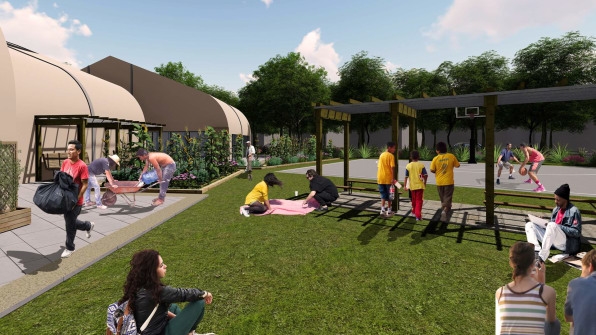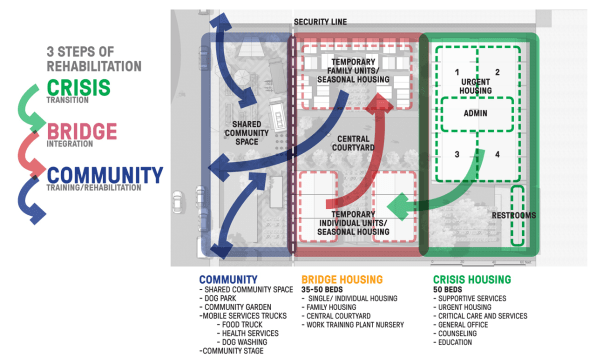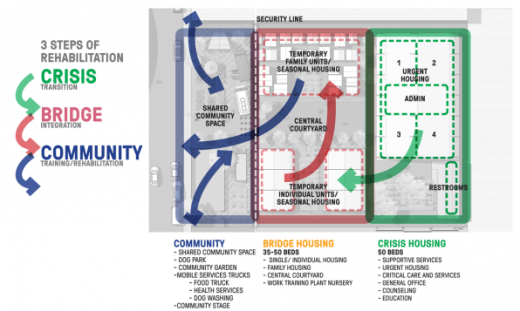Can better design help overcome opposition to helping the homeless?
In the past six years, Los Angeles’s homeless population rose 75%. On a given night in the city, around 55,000 sleep on the street, or in cars or under the shelter of a tent.
The issue is multifaceted, driven in large part by the city’s rising rents and reluctance to build the types of dense, affordable units that could house people living on lower incomes. Residents and city officials alike recognize the need for extreme measures to mitigate the housing shortage: Voters recently approved a tax that would create $4.6 billion to build 10,000 units over the next decade, and a new developer fee is expected to create an additional $100 million per year for affordable housing. Through its recently approved Accessory Dwelling Unit initiative, the city could soon also see around 10,000 new homes pop up in residential yards.
But these solutions will be years in the making. Los Angeles needs a way to house thousands of people cheaply, with dignity, as soon as possible.

Mayor Eric Garcetti’s A Bridge Home plan, introduced earlier this year, aims to do so by allocating around $20 million toward building a homeless shelter in each of the city’s 15 council districts. These shelters are intended to be temporary stop-gaps to house people while construction begins on new units. But gaining resident approval to site 15 homeless shelters throughout the city has proven difficult, even as council members have approved Garcetti’s plan.
“Without a vision from a design perspective, people tend to think the worst,” says Marty Borko, executive director of the L.A. District Council for the Urban Land Institute, a nonprofit that’s extensively studied homelessness in Los Angeles, and advised the city as to how to address it. ULI initially recommended expanding the shelter system to Garcetti in December, and that evolved into the Bridge Home plan. But ULI realized that without a design concept, residents were going to learn of a shelter going up in their neighborhood, and push back.
ULI is a member-based organization that comprises architects, real estate developers, landscape designers, and others invested in the urban landscape. The nonprofit tapped three teams of architects to design concepts for the types of shelters that could emerge as a result of the bridge housing plan. These designs aren’t final, they’re simply meant to act as a starting point for when the city gets approval. But more importantly, the goal is to quell the usual opposition by neighbors to offering homeless services near them by replacing fear-mongering with actual plans.
Over the course of a recent afternoon, the three teams crafted designs that they hoped would alleviate the typical local concerns around homeless shelters. First, traditional shelters are generally not designed with dignity: It’s not unusual to see cot beds lined shoulder to shoulder throughout a large room, with little light or access to good outdoor space. And these utilitarian buildings are often community eyesores.
“We wanted to show that these shelters could fit in communities and be well-designed,” Borko says.

The teams designed shelters for three different capacities: 50 beds, 100 beds, and 150 beds. Each of the designs is vague enough to be tailored to specific lots and communities, but thoughtful enough in its inclusion of specific amenities and design strategies to provide a clear blueprint for how these shelters could work. One, designed by SWA and Studio One Eleven, shows a community garden and dog park, with taco trucks lining the sidewalk before the entrance to the shelter. For privacy, residents of the shelter would walk through a low gate to find a grassy courtyard surrounded by individual units for families, and larger housing structures for individuals. An admin building sits toward the back of the lot, and the whole complex is lined with trees and gardens. The goal of the designs is to do away with the isolation created by traditional shelters and to offer the community surrounding the shelter a space to engage with residents.
In the design renderings, the architectural teams imagined the dwellings will be either steel tents, yurts, or trailers because the shelters will be temporary and need to disassemble easily to make room for true housing units when they’re ready to go up. But they also intended the dwellings to be large enough to include amenities like dressers and armoires for each resident–something traditionally lacking in shelters.
As the city works find viable sites for each of the 15 planned shelters, Borko hopes that these design concepts could help the various city council offices gain approval and productive input from residents. So far, that approval has been slow to materialize. When Herb Wesson, city council president, recently introduced a plan to site a shelter on a lot near the busy intersection of Vermont Avenue and Wilshire Boulevard in Koreatown, he was met with calls to resign. “I think they wish they had tools to show the community how these shelters will look, and what they will offer,” Broko says.
Fast Company , Read Full Story
(26)


